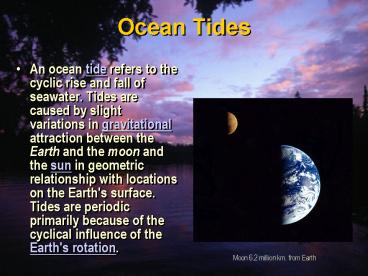Ocean Tides - PowerPoint PPT Presentation
1 / 27
Title:
Ocean Tides
Description:
Ratio of net littoral drift to maximum discharge through inlet. r = MNET/QMAY ... An Inlet System Showing Diversion of Littoral Drift. Types of Ebb Tidal Deltas ... – PowerPoint PPT presentation
Number of Views:191
Avg rating:3.0/5.0
Title: Ocean Tides
1
Ocean Tides
- An ocean tide refers to the cyclic rise and fall
of seawater. Tides are caused by slight
variations in gravitational attraction between
the Earth and the moon and the sun in geometric
relationship with locations on the Earth's
surface. Tides are periodic primarily because of
the cyclical influence of the Earth's rotation.
Moon 6.2 million km. from Earth
2
- St. Michel, N. coast of France
- 16.8 m highest tidal range in Nova Scotia
3
Nova Scotia Tides
- Wolfville, NS (16 m tidal range)
- Diurnal Tides (one high and one low every 12
hours and 25 minutes
4
- Second highest tidal range at Ancorage Alaska
12 m
5
Variable Tides
6
Lunar and Solar Parallax
7
Types of Tides
Spring 1 st. and 3 rd. quarters
Neap new and full moon
8
Spring and Neap Tides
9
Semidiurnal, Mixed and Diurnal Tides
10
Tidal Ranges Around the Globe
11
Tides Around the Globe
12
Tide Curve off Grand Isle
13
Inlets/Inlet Morphology
- Inlet Dynamics determined by
- Tidal currents
- Wave currents
- Longshore sediment supply
- Antecedent geology
14
Tidal Prism/X-Sectional Area
- TIDAL PRISM
- Total amount of H2O flowing into or out of an
inlet with the rise and fall of the tide.
15
AC 2.00 x 10-5 P (OBrien, 1931, 1969) AC
5.44 x 10-6 P1.06 (Jarrett, 1976) NB Changes in
bed shear and littoral supply.
Maximum Inlet Velocity Concept (Escoffier, 1940,
1972)
Maximum velocity curve exists at inlets, along
with a critical x-section area (AC).
16
Inlet By-Passing of Sediment(Bruun, 1966)
Ratio of net littoral drift to maximum discharge
through inlet.
r MNET/QMAY MNET Net littoral drift
(yds3/yr.) QMAX Maximum discharge (yds3/sec.)
r lt 10-20 Tidal flow bypassing r gt 200-300 Bar
bypassing
NOW USED r W/MTOT W Tidal prism (m3/tidal
cycle) MTOT Total/gross drift (m3/yr.)
17
Sediment Sources for Ebb
Shoals
- Longshore transport
- Onshore transport
- Inlet gorge
18
Idealized Free Jet Flowing Through an Orifice
into a Frictionless Receiving Basin
Sectional View of Free Jet Illustrating Seabed
Response at Near Field and Far Field
19
Hypopycnal Flow
Plane jet flow with the reservoir fluid more
dense than the inflowing fluid. This situation is
characteristic of rivers flowing into oceans.
Modified from Bates (1953) By A.J. Scott.
20
Hyperpycnal Flow
A plane jet in which the inflowing fluid is more
dense than the reservoir fluid. This is the
situation prevalent in turbidity flows. Modified
from Bates (1953) By A.J. Scott.
21
Homopycnal Flow
Axial jet flow in which the inflow and reservoir
fluids have the same density. Rapid mixing
associated with this type of inflow results in
deposition of Gilbert-type deltas.
Modified from
Bates (1953) By A.J. Scott.
22
An Idealized Inlet
23
An Inlet System Showing
Diversion of Littoral Drift
24
Types of Ebb Tidal Deltas(after Oertel, 1975)
25
(No Transcript)
26
(No Transcript)
27
(No Transcript)

